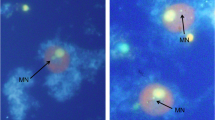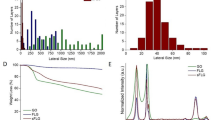Abstract
Formaldehyde (FA), an economically important and ubiquitous chemical, has been classified as a human carcinogen and myeloid leukemogen. However, the underlying mechanisms of leukemogenesis remain unclear. Unlike many classical leukemogens that damage hematopoietic stem/progenitor cells (HSC/HPC) directly in the bone marrow, FA—as the smallest, most reactive aldehyde—is thought to be incapable of reaching the bone marrow through inhalation exposure. A recent breakthrough study discovered that mouse lung contains functional HSC/HPC that can produce blood cells and travel bi-directionally between the lung and bone marrow, while another early study reported the presence of HSC/HPC in rat nose. Based on these findings, we hypothesized that FA inhalation could induce toxicity in HSC/HPC present in mouse lung and/or nose rather than in the bone marrow. To test this hypothesis, we adapted a commercially available protocol for culturing burst-forming unit-erythroid (BFU-E) and colony-forming unit-granulocyte, macrophage (CFU-GM) colonies from bone marrow and spleen to also enable culture of these colonies from mouse lung and nose, a novel application of this assay. We reported that in vivo exposure to FA at 3 mg/m3 or ex vivo exposure up to 400 µM FA decreased the formation of both colony types from mouse lung and nose as well as from bone marrow and spleen. These findings, to the best of our knowledge, are the first empirically to show that FA exposure can damage mouse pulmonary and olfactory HSC/HPC and provide potential biological plausibility for the induction of leukemia at the sites of entry rather than the bone marrow.
Similar content being viewed by others
References
Ballarin C, Sarto F, Giacomelli L et al (1992) Micronucleated cells in nasal mucosa of formaldehyde-exposed workers. Mutat Res/Genet Toxicol 280:1–7. https://doi.org/10.1016/0165-1218(92)90012-O
Beane Freeman LE, Blair A, Lubin JH et al (2009) Mortality from lymphohematopoietic malignancies among workers in formaldehyde industries: the National Cancer Institute cohort. JNCI J Nat Cancer Inst 101:751–761. https://doi.org/10.1093/jnci/djp096
Cogliano VJ, Grosse Y, Baan RA et al (2005) Meeting report: summary of IARC Monographs on formaldehyde, 2-butoxyethanol, and 1-tert-butoxy-2-propanol. Environ Health Perspect 113:1205–1208. https://doi.org/10.1289/ehp.7542
Dash A, Gilliland DG (2001) Molecular genetics of acute myeloid leukaemia. Best Pract Res ClinHaematol 14:49–64. https://doi.org/10.1053/beha.2000.0115
Duong A, Steinmaus C, McHale CM et al (2011) Reproductive and developmental toxicity of formaldehyde: a systematic review. Mutat Res/Rev Mutat Res 728:118–138. https://doi.org/10.1016/j.mrrev.2011.07.003
Ge J, Yang H, Lu X et al (2020) Combined exposure to formaldehyde and PM2.5: hematopoietic toxicity and molecular mechanism in mice. Environ Int 144:106050
Hauptmann M (2003) Mortality from lymphohematopoietic malignancies among workers in formaldehyde industries. Cancer SpectrKnowl Environ 95:1615–1623. https://doi.org/10.1093/jnci/djg083
Hauptmann M, Stewart PA, Lubin JH et al (2009) Mortality from lymphohematopoietic malignancies and brain cancer among embalmers exposed to formaldehyde. JNCI J Nat Cancer Inst 101:1696–1708. https://doi.org/10.1093/jnci/djp416
International Agency for Research on Cancer, Weltgesundheitsorganisation (eds) (2012) IARC monographs on the evaluation of carcinogenic risks to humans, volume 100 F, chemical agents and related occupations: this publication represents the views and expert opinions of an IARC Working Group on the Evaluation of Carcinogenic Risks to Humans, which met in Lyon, 20–27 October 2009. IARC, Lyon
International Agency for Research on Cancer (ed) (2006) IARC monographs on the evaluation of carcinogenic risks to humans, volume 88, formaldehyde, 2-butoxyethanol and 1-tert-butoxypropan-2-ol: this publication represents the views and expert opinions of an IARC Working Group on the Evaluation of Carcinogenic Risks to Humans, which met in Lyon, 2–9 June 2004. IARC, Lyon
Jagannathan-Bogdan M, Zon LI (2013) Hematopoiesis. Development 140:2463–2467. https://doi.org/10.1242/dev.083147
Kobayashi H, Butler JM, O’Donnell R et al (2010) Angiocrine factors from Akt-activated endothelial cells balance self-renewal and differentiation of haematopoietic stem cells. Nat Cell Biol 12:1046–1056. https://doi.org/10.1038/ncb2108
Kondo M (2010) Lymphoid and myeloid lineage commitment in multipotent hematopoietic progenitors: roles of bone marrow microenvironment. Immunol Rev 238:37–46. https://doi.org/10.1111/j.1600-065X.2010.00963.x
Kondo M, Wagers AJ, Manz MG et al (2003) Biology of hematopoietic stem cells and progenitors: implications for clinical application. Annu Rev Immunol 21:759–806. https://doi.org/10.1146/annurev.immunol.21.120601.141007
Lafuse WP, Story R, Mahylis J et al (2013) Leishmaniadonovani infection induces anemia in hamsters by differentially altering erythropoiesis in bone marrow and spleen. PLoS ONE 8:e59509. https://doi.org/10.1371/journal.pone.0059509
Lan Q, Zhang L, Li G et al (2004) Hematotoxicity in workers exposed to low levels of benzene. Science 306:1774–1776. https://doi.org/10.1126/science.1102443
Lan Q, Smith MT, Tang X et al (2015) Chromosome-wide aneuploidy study of cultured circulating myeloid progenitor cells from workers occupationally exposed to formaldehyde. Carcinogenesis 36:160–167. https://doi.org/10.1093/carcin/bgu229
Lefrançais E, Ortiz-Muñoz G, Caudrillier A et al (2017) The lung is a site of platelet biogenesis and a reservoir for haematopoietic progenitors. Nature 544:105–109. https://doi.org/10.1038/nature21706
Leng J, Liu C, Hartwell HJ et al (2019) Evaluation of inhaled low-dose formaldehyde-induced DNA adducts and DNA–protein cross-links by liquid chromatography–tandem mass spectrometry. Arch Toxicol 93:763–773. https://doi.org/10.1007/s00204-019-02393-x
Loh Y-H, Hartung O, Li H et al (2010) Reprogramming of T cells from human peripheral blood. Cell Stem Cell 7:15–19. https://doi.org/10.1016/j.stem.2010.06.004
Lu K, Collins LB, Ru H et al (2010) Distribution of DNA adducts caused by inhaled formaldehyde is consistent with induction of nasal carcinoma but not leukemia. ToxicolSci 116:441–451. https://doi.org/10.1093/toxsci/kfq061
Lu K, Moeller B, Doyle-Eisele M et al (2011) Molecular dosimetry of N2-hydroxymethyl-dG DNA adducts in rats exposed to formaldehyde. Chem Res Toxicol 24:159–161. https://doi.org/10.1021/tx1003886
McGwin G, Lienert J, Kennedy JI (2010) Formaldehyde exposure and asthma in children: a systematic review. Environ Health Perspect 118:313–317. https://doi.org/10.1289/ehp.0901143
Moeller BC, Lu K, Doyle-Eisele M et al (2011) Determination of N2-hydroxymethyl-dG adducts in the nasal epithelium and bone marrow of nonhuman primates following 13CD2-formaldehyde inhalation exposure. Chem Res Toxicol 24:162–164. https://doi.org/10.1021/tx1004166
Murrell W, Féron F, Wetzig A et al (2005) Multipotent stem cells from adult olfactory mucosa. Dev Dyn 233:496–515. https://doi.org/10.1002/dvdy.20360
Nikle A, Liou Y, Ericson M et al (2019) Formaldehyde release from clothing and upholstery fabrics using the chromotropic acid method. Dermatitis 30:255–258. https://doi.org/10.1097/0000000000000460
North TE, Goessling W, Walkley CR et al (2007) Prostaglandin E2 regulates vertebrate haematopoietic stem cell homeostasis. Nature 447:1007–1011. https://doi.org/10.1038/nature05883
Orkin SH, Zon LI (2008) Hematopoiesis: an evolving paradigm for stem cell biology. Cell 132:631–644. https://doi.org/10.1016/j.cell.2008.01.025
Passegue E, Jamieson CHM, Ailles LE, Weissman IL (2003) Normal and leukemic hematopoiesis: are leukemias a stem cell disorder or a reacquisition of stem cell characteristics? Proc Natl AcadSci 100:11842–11849. https://doi.org/10.1073/pnas.2034201100
Pinkerton LE (2004) Mortality among a cohort of garment workers exposed to formaldehyde: an update. Occup Environ Med 61:193–200. https://doi.org/10.1136/oem.2003.007476
Ratajczak MZ, Lee H, Wysoczynski M et al (2010) Novel insight into stem cell mobilization-plasma sphingosine-1-phosphate is a major chemoattractant that directs the egress of hematopoietic stem progenitor cells from the bone marrow and its level in peripheral blood increases during mobilization due to activation of complement cascade/membrane attack complex. Leukemia 24:976–985. https://doi.org/10.1038/leu.2010.53
Renneville A, Roumier C, Biggio V et al (2008) Cooperating gene mutations in acute myeloid leukemia: a review of the literature. Leukemia 22:915–931. https://doi.org/10.1038/leu.2008.19
Tang X, Bai Y, Duong A et al (2009) Formaldehyde in China: production, consumption, exposure levels, and health effects. Environ Int 35:1210–1224. https://doi.org/10.1016/j.envint.2009.06.002
Tomar GB, Srivastava RK, Gupta N et al (2010) Human gingiva-derived mesenchymal stem cells are superior to bone marrow-derived mesenchymal stem cells for cell therapy in regenerative medicine. BiochemBiophys Res Commun 393:377–383. https://doi.org/10.1016/j.bbrc.2010.01.126
Wei C, Wen H, Yuan L et al (2017) Formaldehyde induces toxicity in mouse bone marrow and hematopoietic stem/progenitor cells and enhances benzene-induced adverse effects. Arch Toxicol 91:921–933. https://doi.org/10.1007/s00204-016-1760-5
Ye X, Ji Z, Wei C et al (2013) Inhaled formaldehyde induces DNA–protein crosslinks and oxidative stress in bone marrow and other distant organs of exposed mice: formaldehyde inhalation induces distant toxicity in mice. Environ Mol Mutagen 54:705–718. https://doi.org/10.1002/em.21821
Zhang, L (2018) Formaldehyde: exposure, toxicity and health effects. R Soc Chem 37
Zhang L, Steinmaus C, Eastmond DA et al (2009) Formaldehyde exposure and leukemia: a new meta-analysis and potential mechanisms. Mutat Res/Rev Mutat Res 681:150–168. https://doi.org/10.1016/j.mrrev.2008.07.002
Zhang L, Freeman LEB, Nakamura J et al (2010a) Formaldehyde and leukemia: epidemiology, potential mechanisms, and implications for risk assessment. Environ Mol Mutagen 51:181–191. https://doi.org/10.1002/em.20534
Zhang L, Tang X, Rothman N et al (2010b) Occupational exposure to formaldehyde, hematotoxicity, and leukemia-specific chromosome changes in cultured myeloid progenitor cells. Cancer EpidemiolBiomarkPrev 19:80–88. https://doi.org/10.1158/1055-9965.EPI-09-0762
Zhang L, Prak L, Rayon-Estrada V et al (2013) ZFP36L2 is required for self-renewal of early burst-forming unit erythroid progenitors. Nature 499:92–96. https://doi.org/10.1038/nature12215
Zhang Y, Liu X, McHale C et al (2013) Bone marrow injury induced via oxidative stress in mice by inhalation exposure to formaldehyde. PLoS ONE 8:e74974. https://doi.org/10.1371/journal.pone.0074974
Acknowledgements
This project was partially supported by NIEHS Superfund research grant P42ES004705 and Chau Hoi Shuen Foundation Women in Science Program Award at University of California at Berkeley (L Zhang), as well as the National Key Research and Development Program of China (2017YFC0702700) (R Li). The content is solely the responsibility of the authors and does not necessarily represent the official views of NIEHS and other funding agencies. We thank Dr. Zhe Liu from University of California, San Francisco (UCSF) at Dr. Looney's lab for her valuable suggestions on the protocol of lung cell extraction. YZ is a recipient of the China Scholarship Council for a graduate fellowship to UC Berkeley for 2 years (201706770048).
Author information
Authors and Affiliations
Corresponding authors
Ethics declarations
Conflict of interest
All of the authors declare no potential competing financial interest.
Additional information
Publisher's Note
Springer Nature remains neutral with regard to jurisdictional claims in published maps and institutional affiliations.
Rights and permissions
About this article
Cite this article
Zhao, Y., Magaña, L.C., Cui, H. et al. Formaldehyde-induced hematopoietic stem and progenitor cell toxicity in mouse lung and nose. Arch Toxicol 95, 693–701 (2021). https://doi.org/10.1007/s00204-020-02932-x
Received:
Accepted:
Published:
Issue Date:
DOI: https://doi.org/10.1007/s00204-020-02932-x









